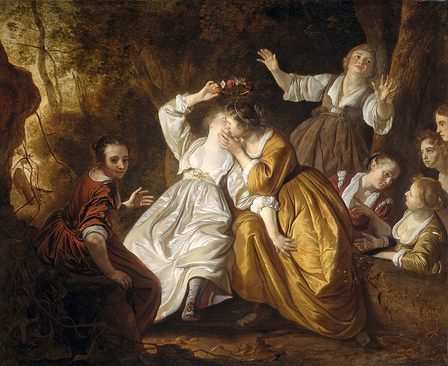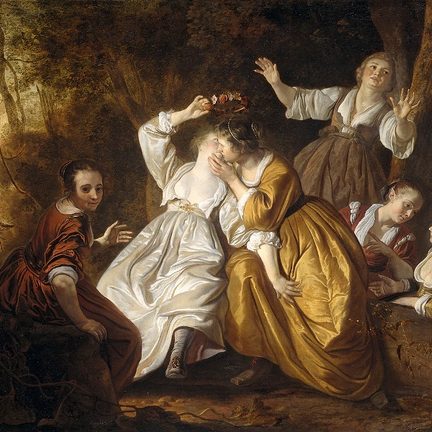Ode to Hendrickje Lamberts van der SchuurSorrowing in her Sex

This text was translated using AI and may contain errors. If you have suggestions or comments, please contact us at info.ode@amsterdammuseum.nl.
Dear Hendrickje,
Yesterday I was sitting with a writer friend in a pub in the Huidenstraat. This part of town, today called the Nine Streets, was built at the beginning of the seventeenth century, when you lived in Amsterdam. Perhaps, I thought, there was also a pub to be found at or near that spot back then. And maybe in the seventeenth century, until recently also called the Golden Age, you also sat there sometimes, with or without Trijntje.
My friend and I discussed the complications of writing this kind of letter: how do you communicate with someone from the past (a stone's throw from that café, in the Jordaan, in your time there were meadows with ditches), how do you avoid making assumptions (could you go to the pub as a woman back then?) and your ignorance becoming offensive (were you really a woman?), how do you avoid explaining the other person's own life to them? (Mansplaining, it's called these days. Because yes, we are more or less friends with the British and their post-colonial descendants and use many of their words).
In short, how do you make sure you behave a bit civilised? Especially to someone you are writing to from a position of privilege, someone who has had a hard time.
Which also existed in your time: the Mauritshuis in ‘s Gravenhage, though it was not a print museum then. In that world-famous museum in The Hague hangs a famous painting by your very celebrated contemporary, Rembrandt van Rijn, The Anatomy Lesson of Dr Nicolaes Tulp, painted in 1632. Doctor Tulp is standing over the marble-grey corpse of Aris Kindt, sentenced to death for theft, forceps in hand, arm tendons between them, while seven men look on. In terms of touch, colour and incidence of light, it is a test of mastery (Rembrandt was 25 when he painted it), but it is not a masterpiece, for that the punctum of the painting leaves too much to be desired: the surgeons, except for one, are not looking at the ‘lesson’, their somewhat deadly gazes roam somewhat through space, the concentricity is lacking, even for the viewer.
Yes, even Rembrandt had something to learn (compare it to The Steel Masters, from 1662, I wanted to say, which came to hang in the Staalhof almost immediately after its completion, but by then you had already been exiled from the city).
“You know this chilly Tulip too. As your interrogator, jury and judge. As your executioner of love.”
The anatomy lesson says a lot about some attitudes of your time and mine: a death sentence for theft, we would now call that cruel and barbaric; performing an autopsy without consent is unlawful; and there are even voices saying that the titles of many famous paintings are cruel and incorrect. That title in this case should be something like The Unconsented Autopsy of Aris Kindt. Anyone who steps beyond the penchant for the old and familiar, anyone who lets go of the recognisable, palpable irritation with reprimands for a moment, I think, comes to the conclusion that there is something to be said for that.
Be that as it may, it is through Aris Kindt's unapologetic autopsy that I have a face for the cold, clinical version of Nicolaes Tulp (in Hals and Pickenoy's portrait he comes across as cordial). You also know this chilly Tulp. As your interrogator, jury and judge. As your love executioner.
Forgive me: Tulp, born Claes Pieterszoon, was, as you know, a doctor, a man of science, as well as dean, a member of the city council and the city court (and later mayor), but also a writer, known for his Observationes Medicae, Medicine Observations, from 1641. In it, Tulp describes his experiences as a physician. I read some parts of that book two years ago, in Dutch, because I wanted to write a piece about Homo sapiens ferus, (young) people raised in the wild, also called ‘wolf children’. In the 17th century, there was a boy from Ireland who had lived with sheep in the wild and was put on display after his ‘capture’, including in Amsterdam. The boy could not talk; he continued to bleat all his life. Tulp did not treat this boy; he ‘visited’ him out of interest.
A trapped, incarcerated child toured Europe in the name of science. Nowadays, I think we would also call such a thing barbaric and disenfranchised, although much is still allowed for the benefit of science: in the Netherlands, researchers do almost half a million animal experiments a year; thousands of animals (fish, pigs, birds) die for it, sometimes even without having been ‘used’.
Enfin.
Tulp, as a doctor, helped people, was an inspired, writing scientist, a committed city councillor, but by today's not infallible moral standards, not always exalted. In 1672, at the time of the plague, he did an Amaliate: large gatherings of people were forbidden, but that did not stop the best man from throwing a big party in his backyard for his own 50th anniversary of office.
But you know this too, all of you, Hendrickje, if it is not certain that you were still alive in 1672 and whether that latest news reached you. But you and Tulp met. You are even in his book! Though I must admit that I read that in a focused way, and not from cover to cover, and did not come across your name on that first reading, some years ago.
There's a good chance you don't know this, so I'm happy to share. This is how Tulp wrote you down in history: ‘Hendrikje Schuur, a Woman of a Man's Courage, having grief in her Sex, put on man's clothes, and leaving for war, served for some time in the Siege of “s Hertogenbosch, under Frederik Hendrik, august Prince of Orange.”
“In her interrogation, Trijntje confessed that you spoke words together, slept together and had had ‘vleijschelijcke conservatie’ as with ‘haer deceased husband’.”
Ik probeer het even naar deze tijd te vertalen: je had ‘mannenmoed’ omdat je in het leger diende, voelde ‘verdriet’ over het gebrek aan vrijheid rondom je genderidentiteit, droeg ‘mannenkleding’.
Wat verder over je te vinden is: je kwam uit Amersfoort, werd rond 1610 geboren, vocht in 1629 als tiener bij het beleg van Den Bosch onder aanvoering van van Kapitein Roobol twee jaar lang tegen de Spanjaarden (ook vrienden, tegenwoordig), kwam naar Amsterdam, kleedde je daar eerst niet meer en toen weer wel als man.
Tulp wist dit allemaal, omdat hij in de zomer van 1641 als schepen aanwezig was, toen jij gevangen was gezet in het (thans afgebrande) stadhuis op de Dam. Hij was verantwoordelijk voor jouw verhoor en ook dat van de vrouw met wie jij samenleefde, Trijntje Barents (ca. 1608 - na 1664, moeder van zes kinderen, van wie er in 1641 nog drie leefden).
In haar verhoor bekende Trijntje dat jullie samenwoorden, samen sliepen en ‘vleijschelijcke conservatie’ hadden gehad zoals met ‘haer overleden man’. Ze zij ook dat zij en jij ‘wel gesint sijn geweest malkanderen te trouwen, zoo t zelve geoorloft ware geweest’. Kortom, jij en Trijntje hielden van elkaar, en jullie liefde beviel het stadsbestuur niet.
In je eigen verhoren vertelde je Tulp dat je in Den Bosch was lastiggevallen als je in vrouwenkleren rondliep, en nu in Amsterdam weer, maar nu als je mannenkleding droeg. Jouw ‘mannelijke gedrag’ interesseerde Tulp, enzijn rollen als arts en deken vermengden zich al snel, zoals Tom van der Molen schrijft in Ons Amsterdam. In de ondervragingen is een obsessie met jouw geslachtsdeel te bespeuren; in het bijzonder met de grootte van je clitoris, die Tulp door drie vroedvrouwen liet onderzoeken, en het verband dat er zou zijn met je soldaat-zijn, seksuele voorkeur, je libido en je kleding. Tulp beschrijft je clitoris als een ‘roede’, volgens Van der Molen in jouw tijd een gangbaar woord voor ‘pik’. De arts en deken laat zich laatdunkend over je uit, en zowel zijn medische als juridische blik worden door dat oordeel gekleurd. Van der Molen slaat de spijker op zijn kop als hij schrijft dat Tulp vanuit een moderne blik gezien veel door elkaar haalt. Een probleem is natuurlijk dat we door die gekleurde blik naar jou kijken en we dus niet goed kunnen weten wie je was. Van je pijn en verdriet kunnen we ons enkel een voorstelling maken.
Wat we wel weten: op 2 augustus 1941 werden jij en Trijntje - binnenskamers - gegeseld. Jij werd vervolgens voor 25 jaar verbannen uit Amsterdam, waar Trijntje en haar kinderen woonden en leefden. Omdat jullie van elkaar hielden en de liefde buiten de heersende seksuele- en gendernormen viel. Tulp noteert naderhand dat hij vindt dat jullie eigenlijk de doodstraf hadden verdiend, maar door jullie zo te straffen en te scheiden meende hij dat ‘dat ongeoorloofde bed van verfoejelijke wellust genoeg gescheiden [scheen] te werden’.
Het spijt me wat er jou is aangedaan in deze stad.
Hendrickje, ik zal je geen knollen voor citroenen verkopen, ook nu heerst er nog veel trans- en homohaat en zijn er politici die dit sentiment verwoorden en voor eigen gewin gebruiken; laakbaar gedrag. De mens heeft een hang naar de status quo, gedraagt zich vaak wreed en vaak ongeoorloofd in strijd met allerlei verdragen; vooruitgang is niet vanzelfsprekend maar moet elke dag opnieuw worden bevochten, en toch wil ik je het volgende niet onthouden: afgelopen week vond hier in jouw verkozen stad Pride plaats, een meerdaags publieksevenement met honderdduizenden bezoekers, ongeveer gelijk aan de jaarlijkse bezoekers van het Mauritshuis. Ook de Pride is niet geheel onbesproken, maar zulke aantallen geven hoop. En een handvat: zó gaan we in Amsterdam met elkaar om.
Met vriendelijke groet,
Philip Huff
Period
1609– 1659
About
Ode by Philip Huff to Hendrikje Lamberts van der Schuur
He wrote this ode to provide some commentary on the image of Amsterdam as the ‘gay capital’ and to provide insight into the patriarchal violence against women.

Hendrickje Lamberts van der Schuur
Hendrikje Lamberts van der Schuur (c. 1610/14-??) wore men's clothes or women's clothes at different periods during her life. Hendrikje served in Prince Frederik Hendrik's army was eventually convicted of a relationship with Trijntje Barents (c. 1608 - after 1664).